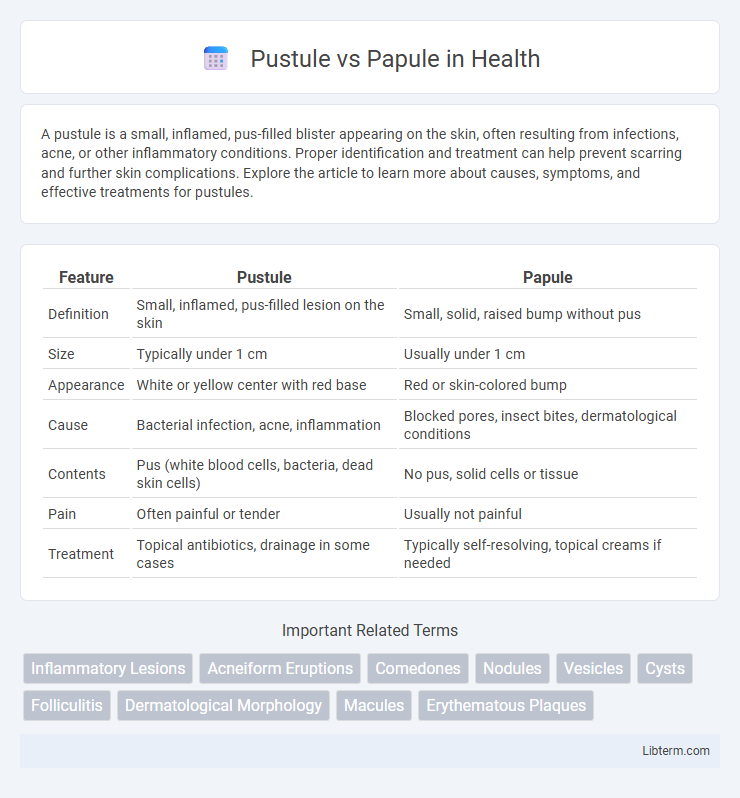A pustule is a small, inflamed, pus-filled blister appearing on the skin, often resulting from infections, acne, or other inflammatory conditions. Proper identification and treatment can help prevent scarring and further skin complications. Explore the article to learn more about causes, symptoms, and effective treatments for pustules.
Table of Comparison
| Feature | Pustule | Papule |
|---|---|---|
| Definition | Small, inflamed, pus-filled lesion on the skin | Small, solid, raised bump without pus |
| Size | Typically under 1 cm | Usually under 1 cm |
| Appearance | White or yellow center with red base | Red or skin-colored bump |
| Cause | Bacterial infection, acne, inflammation | Blocked pores, insect bites, dermatological conditions |
| Contents | Pus (white blood cells, bacteria, dead skin cells) | No pus, solid cells or tissue |
| Pain | Often painful or tender | Usually not painful |
| Treatment | Topical antibiotics, drainage in some cases | Typically self-resolving, topical creams if needed |
Understanding Skin Lesions: Pustule vs Papule
Pustules and papules are common types of skin lesions distinguished by their content and appearance. A pustule is a small, inflamed, pus-filled blister typically caused by bacterial infection, such as acne or folliculitis, appearing white or yellow with a red base. Papules are solid, raised bumps without pus, resulting from inflammation or buildup of cells, and are characteristic of conditions like eczema, psoriasis, or dermatitis.
What is a Pustule?
A pustule is a small, inflamed, pus-filled blister on the skin, typically caused by bacterial infection or clogged pores. It is characterized by a raised, red base with a yellow or white center containing pus, distinguishing it from a papule, which is solid and lacks pus. Common conditions featuring pustules include acne, folliculitis, and pustular psoriasis.
What is a Papule?
A papule is a small, raised, solid skin lesion typically less than 1 centimeter in diameter, characterized by its firm texture and absence of pus. Unlike pustules, which contain visible pus and indicate infection or inflammation, papules are often a sign of dermatological conditions such as acne, eczema, or psoriasis. These lesions result from localized skin cell proliferation or inflammation without fluid accumulation.
Key Differences Between Pustules and Papules
Pustules are inflamed, pus-filled lesions that appear raised and typically indicate infection or acne, while papules are small, solid, raised bumps without pus, often representing early-stage acne or other skin conditions. Pustules usually exhibit a white or yellow center surrounded by redness, contrasting with papules' uniform color and firmness. The presence of pus in pustules signifies active inflammation, whereas papules are non-infectious and primarily characterized by skin thickening.
Causes of Pustules
Pustules are caused by infections, often bacterial, leading to the accumulation of pus beneath the skin, with common triggers including acne vulgaris, folliculitis, and impetigo. Papules, in contrast, are solid, inflamed bumps without pus, usually resulting from conditions like eczema, psoriasis, or dermatitis. Understanding the underlying cause helps differentiate pustules caused by microbial invasion from papules driven by inflammatory or allergic responses.
Causes of Papules
Papules are small, raised, solid lesions often caused by conditions such as acne, eczema, or allergic reactions, resulting from inflammation or hyperplasia of the skin cells. In contrast, pustules contain pus due to bacterial infection, commonly seen in infectious acne or impetigo. Understanding the inflammatory and non-infectious nature of papules aids in differentiating them from pustules in dermatological diagnoses.
Symptoms and Appearance Comparison
Pustules present as small, raised lesions filled with pus, often appearing red at the base with a white or yellow center, indicating localized infection or inflammation. Papules are firm, raised bumps without pus, usually under 1 centimeter in diameter, and can vary in color from pink to brown depending on skin type and condition. Both pustules and papules are common in acne and skin infections, but pustules are characterized by visible pus, while papules are solid and non-fluid-filled.
Diagnosis: Identifying Pustules and Papules
Pustules are small, inflamed, pus-filled lesions typically appearing white or yellow with a red base, making them distinguishable from papules, which are solid, raised bumps without pus. Diagnosis involves careful clinical examination under magnification to assess lesion content and appearance, often supplemented by dermoscopy for enhanced visualization of structural differences. Accurate identification of pustules versus papules is crucial for determining appropriate treatment strategies in conditions such as acne, rosacea, and other dermatological disorders.
Treatment Options for Pustules and Papules
Treatment options for pustules typically include topical antibiotics like clindamycin or benzoyl peroxide to reduce bacterial infection and inflammation, while oral antibiotics or corticosteroids may be prescribed for severe cases. Papules are generally treated with topical retinoids such as tretinoin or adapalene to promote skin cell turnover, alongside anti-inflammatory agents to minimize redness and swelling. Both pustules and papules benefit from consistent skincare routines that include gentle cleansing and non-comedogenic moisturizers to prevent further irritation.
Prevention and Skin Care Tips
Preventing pustules and papules involves maintaining a consistent skincare routine that includes gentle cleansing with non-comedogenic products and regular exfoliation to remove dead skin cells. Using oil-free moisturizers and avoiding excessive touching or picking at the skin can reduce inflammation and bacterial growth. Incorporating topical treatments containing salicylic acid or benzoyl peroxide helps to prevent clogged pores and bacterial infections that lead to these common acne lesions.
Pustule Infographic

 libterm.com
libterm.com